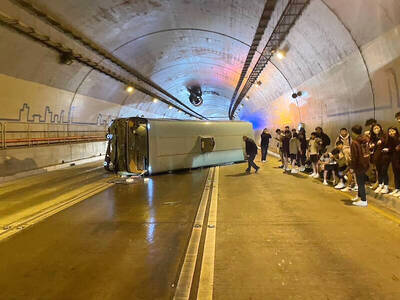A Japanese geologist who said faultlines located near the Fourth Nuclear Power Plant in Gongliao Township (貢寮), Taipei County, would threaten the safety of the plant in the event of an earthquake has urged Taiwan Power Co (Taipower) to base its claims to the contrary on scientific evidence.
An experienced researcher on the effect of geological composition on building safety, Shiosaka Kunio located a new fault along the Gongliao coast near the Fourth Nuclear Power Plant during a three-day inspection last week.
Aside from the newly discovered fault, two other faults — the Fangjiao Fault (枋腳斷層) and the Shanjiao Fault (山腳斷層) — have been identified in the area where the power station is located.
At a press conference at the legislature, Shiosaka said the faults could threaten the safety of the Fourth Nuclear Power Plant during an earthquake.
In response, Taipower asked how Shinosaka could locate a new fault in only three days and said that the faults the nuclear power plant sits on are inactive.
In a press release, the energy company claimed that after discussions with them, Shiosaka had agreed that one of the faults that runs through the grounds of the power plant was a shear zone rather than a fault.
In a written statement, Shiosaka said he was able to locate the new fault in a short time because he investigated the geological composition of the area with the help of a remote sensing technique and satellite imagery.
“Professionals who are involved in relevant areas should challenge me only after inspecting the area in person,” he said.
“As long as there’s a fault, the impact of an earthquake would be amplified at least 1.5 times more, whether it’s an active fault or not,” Shiosaka said.
“It’s meaningless to differentiate between active and inactive, because those definitions are artificial,” he said.
In Japan, an “inactive fault” is defined as a fault that has not been active for 1 million years. In Taiwan, the definition is limited to a period of 125,000 years.
“Taipower says the Fanjiang Fault is inactive because it hasn’t been active for 37,000 years,” Shiosaka said. “This is extremely unprofessional, as it’s not even in accordance with Taiwan’s own definition of what an ‘inactive fault’ means.”
Turning to the recently discovered fault, which is located near the fishing harbor in Aodi Village (澳底), Shiosaka said the fault had caused cracks on the levee of the harbor.
“The levee was built no more than 30 or 50 years ago. Though I don’t know the exact year, it means the fault has moved in recent decades,” he said.
Shiosaka criticized Taipower for claiming he agreed that the “fault” that ran through the nuclear power plant grounds was not a fault.
“I strongly condemn Taipower for this fabricated statement,” he said.
“The job of scientists is to serve the people, but there are some people who cover up their hearts to protect their interests,” Shiosaka said.
“Everyone makes mistakes, I make mistakes too, but scientists should always base their remarks on scientific evidence. I hope one day we can have a discussion based on hard facts to determine what’s best for the public,” he said.

The Central Weather Administration (CWA) today issued a "tsunami watch" alert after a magnitude 8.7 earthquake struck off the Kamchatka Peninsula in northeastern Russia earlier in the morning. The quake struck off the east coast of the Kamchatka Peninsula at 7:25am (Taiwan time) at a depth of about 19km, the CWA said, citing figures from the Pacific Tsunami Warning Center. The CWA's Seismological Center said preliminary assessments indicate that a tsunami could reach Taiwan's coastal areas by 1:18pm today. The CWA urged residents along the coast to stay alert and take necessary precautions as waves as high as 1m could hit the southeastern

The National Museum of Taiwan Literature is next month to hold an exhibition in Osaka, Japan, showcasing the rich and unique history of Taiwanese folklore and literature. The exhibition, which is to run from Aug. 10 to Aug. 20 at the city’s Central Public Hall, is part of the “We Taiwan” at Expo 2025 series, highlighting Taiwan’s cultural ties with the international community, National Museum of Taiwan Literature director Chen Ying-fang (陳瑩芳) said. Folklore and literature, among Taiwan’s richest cultural heritages, naturally deserve a central place in the global dialogue, Chen said. Taiwan’s folklore would be immediately apparent at the entrance of the

“China is preparing to invade Taiwan,” Deputy Minister of Foreign Affairs Francois Wu (吳志中) said in an exclusive interview with British media channel Sky News for a special report titled, “Is Taiwan ready for a Chinese invasion?” the Ministry of Foreign Affairs said today in a statement. The 25-minute-long special report by Helen Ann-Smith released yesterday saw Sky News travel to Penghu, Taoyuan and Taipei to discuss the possibility of a Chinese invasion and how Taiwan is preparing for an attack. The film observed emergency response drills, interviewed baseball fans at the Taipei Dome on their views of US President

Speeding and badly maintained roads were the main causes of a school bus accident on a rainy day in Taipei last year that severely injured two people and left 22 with minor injuries, the Taiwan Transportation and Safety Board said. On March 11 last year, a Kang Chiao International School bus overturned inside the Wenshan Tunnel (文山隧道) on the northbound lane of the Xinyi Expressway. The tour bus, owned by Long Lai Co, exceeded the speed limit after entering the tunnel, the board’s investigation found. Sensing that the rear of the vehicle was swaying, the driver attempted to use the service and exhaust